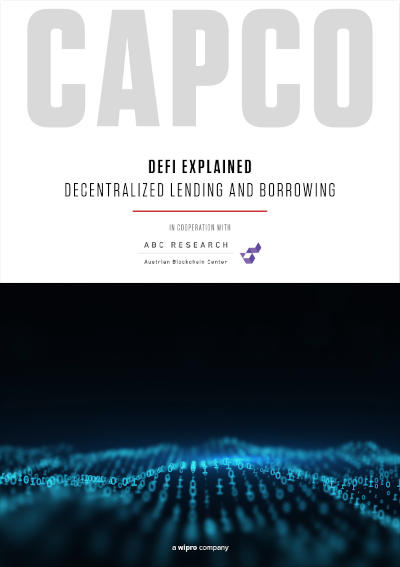Introduction
Decentralized Finance (DeFi) is a rapidly growing domain that offers an alternative to traditional lending and borrowing. In this blog post, we will explore the key elements of a recent CAPCO’s report on DeFi lending and borrowing, written in collaboration with the Austrian Blockchain Center.
We will discuss the market size and major players, the design and specifics of lending pool solutions, the differences between DeFi and traditional lending, and the benefits and risks associated with DeFi lending.
By the end of this post, you will have a comprehensive understanding of DeFi lending and borrowing and why it is an exciting and promising domain.
Market Size and Major Players
One of the benefits of the transparency of public blockchains is that decentralized lending applications can be observed with the help of blockchain data. According to the report, the total value locked (TVL) in DeFi lending protocols was $15.6 billion as of May 11th, 2023 [page 10]. The major players in the DeFi lending space include Compound, Aave, MakerDAO, and Uniswap.
These platforms allow users to lend and borrow cryptocurrencies without the need for intermediaries such as banks.

Design and Specifics of Lending Pool Solutions
Lending pool solutions are a key component of DeFi lending. In a lending pool, users can deposit their cryptocurrencies, which are then lent out to borrowers. The interest earned from the loans is distributed among the depositors. The report describes the design and specifics of widely used lending pool solutions, such as Compound and Aave [page 2].
These platforms use smart contracts to automate the lending and borrowing process and ensure that the loans are fully collateralized.
Differences Between DeFi and Traditional Lending
There are several important differences between DeFi and traditional lending. For example, DeFi lending solutions have indefinite loan maturity, which means that borrowers can repay their loans at any time without penalty. In contrast, traditional loans have fixed repayment schedules.
Another difference is the liquidation process in the event of a default. In DeFi lending, the collateral is automatically liquidated if the value of the collateral falls below a certain threshold. In traditional lending, the lender may have to go through a lengthy legal process to recover their funds.
Benefits and Risks of DeFi Lending
DeFi lending offers several benefits, such as tapping into global liquidity sources and the promise of additional interest income. Banks can also explore DeFi lending by partnering with DeFi lending platforms, which can provide an opportunity for learning in terms of know-how and experience.
However, there are also risks associated with DeFi lending, such as smart contract vulnerabilities and market volatility. It is important to thoroughly understand these risks and take steps to mitigate them.
Conclusion
In conclusion, DeFi lending and borrowing is a rapidly growing domain that offers an alternative to traditional lending. The market size of DeFi lending protocols is already significant, and major players such as Compound and Aave are leading the way.
Lending pool solutions are a key component of DeFi lending, and they use smart contracts to automate the lending and borrowing process. There are several important differences between DeFi and traditional lending, such as indefinite loan maturity and the liquidation process in the event of a default. While DeFi lending offers several benefits, it is important to understand and mitigate the risks associated with this domain.

Leave a Reply